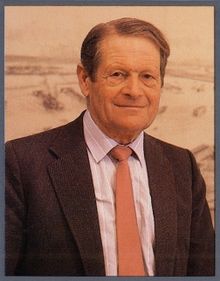Allan Beckett
| Allan Harry Beckett | |
|---|---|
 |
|
| Born |
4 March 1914 East Ham, London |
| Died | 19 June 2005 (aged 91) Farnborough, Kent |
| Buried | Oare churchyard, Faversham, Kent (51°20′02.47″N 00°52′54.26″E / 51.3340194°N 0.8817389°E) |
| Allegiance |
|
| Service/branch | Royal Engineers |
| Years of service | 6 |
| Rank | Major |
| Awards | MBE |
| Other work | Sir Bruce White, Wolfe Barry & Partners. Beckett Rankine |
Allan Harry Beckett MBE (b. 4 March 1914, East Ham, London Borough of Newham, United Kingdom, d. 19 June 2005, Farnborough, London) was a civil engineer whose design for the 'Whale' floating roadway was crucial to the success of the Mulberry harbour that was used in the Normandy Landings. Starting the war as a sapper digging trenches on the South Coast at the time of the Dunkirk evacuation, Allan Beckett came to play a significant rôle in the success of the Mulberry harbour used during and after the Normandy landings of June 1944.
His contribution to the Mulberry was to design the floating roadways which connected the pierhead to the shore, and a system of anchors. The roadway had to be strong enough to withstand constant wave action which, as occurred in the appalling weather of June 1944, was much more severe than anticipated. Beckett's design, which had been tested in the severe conditions of Scotland in winter, survived the storm which struck on 19 June 1944, and raged for three days.
Allan Beckett was born on 4 March 1914 in East Ham, London; the eldest of three children of George William Harry Beckett and his wife Emma (née Stokes). Allan's father was a professional soldier in the Royal Field Artillery and was proud to be one of the 'Old Contemptibles'. London Borough of Newham have placed a blue heritage plaque on the house in Montpelier Gardens where the family lived. Allan's first interest was mechanical engineering – he was a keen model maker, building intricate model boat engines when a teenager. However his father persuaded him to study civil engineering at university as the career prospects were better.
He read civil engineering at the University of London and was then apprenticed to Sanders and Forster, steelwork and structural engineers from 1930–33. From there he moved to the bridge department of consulting engineers A. J. Bridle until the war began. He volunteered for the Royal Engineers in January 1940 and, after basic sapper training, was at the time of the Dunkirk evacuation engaged in trench digging, watch duties and manning a searchlight at Folkestone Harbour. He also assisted in the sinking of the block ship Umvoti across the harbour's entrance. Commissioned in 1941, he was sent to King's Newton, near Derby, to work for Lieutenant-Colonel W. T. Everall, a specialist on the rapid construction of railway bridges for battlefield use. In this position, he gained valuable experience in assembling light steel bridging.
...
Wikipedia
